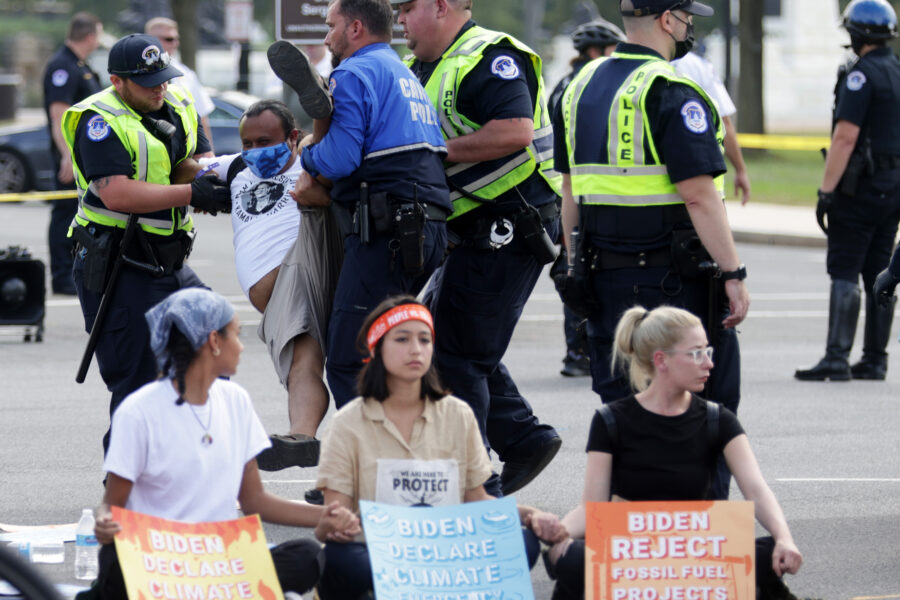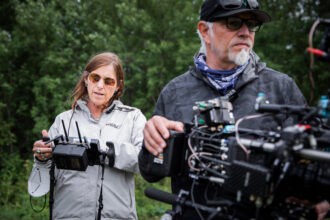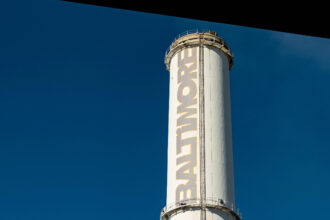How Johns Hopkins Scientists and Neighborhood Groups Model Climate Change in Baltimore
It was a no brainer, Ben Zaitchik thought, standing outside in hiking shorts and a t-shirt. What else to wear on a day when the temperature was set to soar above 90 degrees? The air felt stuffy on this muggy afternoon in late August.
A professor and climate scientist at Johns Hopkins University’s Department of Earth and Planetary Sciences, Zaitchik and his graduate assistant, Ali Eyni, prepared to ride bicycles on a 17-mile loop of the city, measuring maximum temperatures at the height of a blistering heat wave to record temperature variations between neighborhoods with little tree canopy and those with better tree cover and more green spaces.
Zaitchik hoped the data will help create more precise models applicable to other cities with similar urban features. He and a Hopkins colleague, Darryn Waugh, had carefully plotted the route, stitching together Baltimore’s greener neighborhoods and those that faced unique environmental challenges.
Waugh had also arranged to borrow a temperature-recording bike from Mike Alonzo, a professor at American University. It looked like a regular bike except for the pole-mounted temperature device attached to its rear. The “bike-mounted rapid response thermometer” is used to capture spatial temperature variations across neighborhoods, Zaitchik explained. “We are seeing significant differences in temperature between urban areas and vegetated park spaces.”
Explore the latest news about what’s at stake for the climate during this election season.
He peered at his watch. It was quarter to one and the plan was to leave no later than 1 p.m. The bike needed to sit outside for 10 to15 minutes to acclimate. Zaitchik had already loaded their route into an interactive GPS program—standard software cyclists often use when mapping a course.
“We’ve done this ride six or seven times,” he said. “Looking at the map, you can see lots of fine-scale structures between parks and streets. You also see that the south is hotter than the north, which we believe is mostly a real distinction because it also shows up in stationary weather stations we have along the route—but we need to be careful about temperature changes while we are riding.”
Precisely at 1 p.m., the duo rode off, with Zaitchik astride the special bicycle. They turned onto tree-lined San Martin Drive on the west side of Hopkins’ Homewood campus and pedaled toward the Old Goucher neighborhood.
For the past two years, Zaitchik, Waugh and numerous other colleagues at Johns Hopkins University have been busy implementing a $25 million, 5-year project called the Baltimore Social-Environmental Collaborative, or BSEC, for short. It draws on the expertise of scientists, academics, researchers, climate modeling specialists and other experts from Hopkins, Pennsylvania State University, Morgan State University and the University of Maryland, Baltimore County, among others.
The initiative is part of a larger $66 million grant from the U.S. Department of Energy to develop “Urban Integrated Field Laboratories” in three U.S. cities—Baltimore, Chicago and Port Arthur-Beaumont, Texas—through collaborations between universities, government entities and nonprofit affiliates. The Biden administration’s goal: a net-zero economy by 2050.
The challenge before the BSEC researchers is to figure out how atmospheric, climatic and environmental factors interact across Baltimore and come up with equitable climate adaptation strategies. Zaitchik, one of the project leads, believes this would allow Baltimore, and cities like it, to withstand pressures from climate change, while prioritizing investments in historically underserved communities.
Since they received the grant in 2022, Zaitchik and his colleagues have installed weather instruments in over 30 locations across the city, which allow the team to quantify, for example, the temperature variations between neighborhoods with little tree canopy and those with better tree cover and more green spaces. He hopes the data will help create more precise models applicable to other cities with similar urban features.
Separately, six focus groups had been tasked to work on four key project areas related to climate change—urban heat, flooding, air pollution and decarbonization. Zaitchik felt that a good chunk of his time went into putting community concerns at the heart of what’s primarily a scientific endeavor. That resulted in collaboration with citizen groups active in east and central Baltimore, which led to citizen science initiatives bringing together experts and local advocates.
Those local organizations are now BSEC partners and independently formed a city-wide coalition of six communities called the Baltimore Climate Resilience Coalition. Drawing on their experiences, the coalition aims to turn the participating neighborhoods into green, pedestrian-friendly communities.
“That’s a success. And it warms my heart,” Zaitchik said.
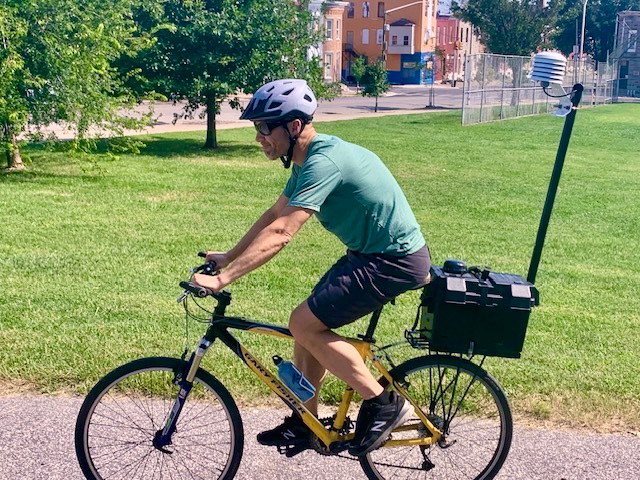
Now, as Zaitchik and Eyni followed the carefully drawn course in the sweltering heat, Zaitchik thought the day’s random passing clouds were the only saving grace. Luckily, both men had dressed to stay ventilated.
Heat is a phenomenon Zaitchik, 46, knows a lot about. A Boston native who got his Ph.D. at Yale, he started his career studying hurricane-induced landslides in the Middle East. Now, he’s an expert in urban heat islands, a persistent problem for Baltimore caused by high summertime temperatures, humidity and heat-retaining structures that push temperatures to extremes.
Heat islands are most likely to be located in underserved communities, Zaitchik knew from experience. Fewer green spaces and a lack of shaded areas, retention ponds and green patches make it particularly hard for them to cope with extreme heat, rains and floods. Riding in scorching heat was just a fleeting reminder of the challenging conditions residents dealt with every day.
The ride took them through the relatively shaded median of Broadway Avenue in the Broadway East neighborhood. Then they turned left behind the Great Blacks in Wax Museum and continued into the substantially less tree-lined side streets of that neighborhood.
Further along, Zaitchik and Eyni popped out of the forested bike path in Herring Run Park and onto freshly paved asphalt, leading westward toward downtown. Then they looped through Collington Square Park—a small green area next to a recreation center that is up on a small hill that catches the afternoon breeze—before diving down onto a block of mostly vacant brick row houses with no shade at all.
At a couple of intersections, cars stopped and let them pass in front of them on a turn, probably because of the weird looking bike with the temperature antennae caught their attention. At one point, when they were stopped, a middle-aged man approached and asked if they were measuring something. When Zaitchik told him they were gauging temperatures, the man nodded and gave them a thumbs up.
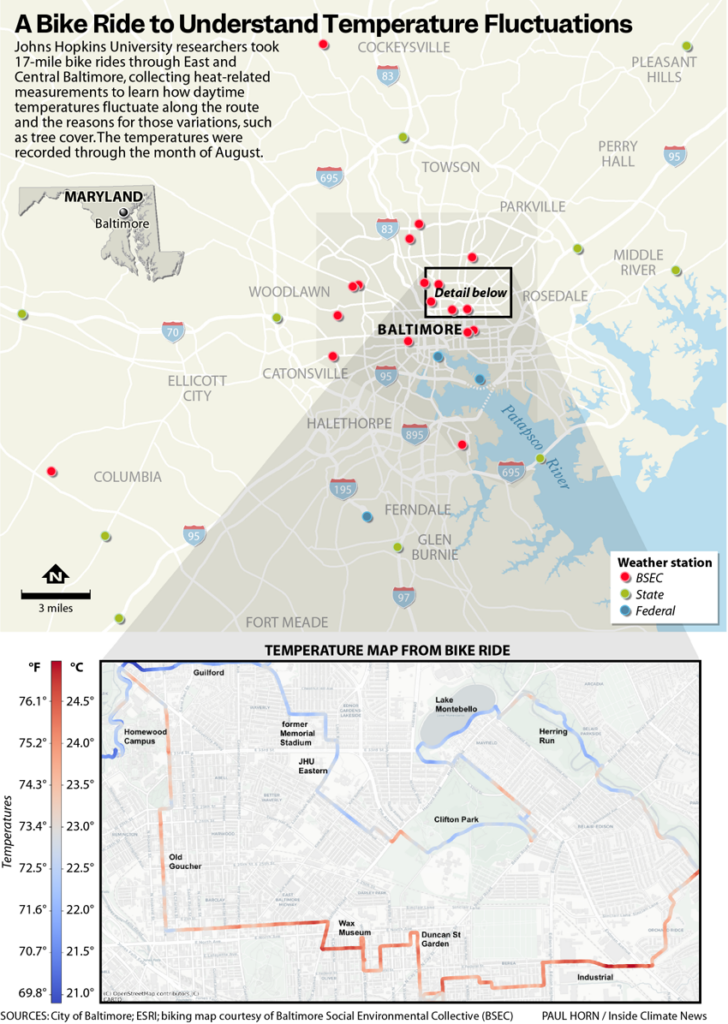
The ride was exhausting. Seeing the campus getting closer in the distance, after almost 2 hours of cycling in blistering heat, Zaitchik felt a sense of relief. Their clothes were soaked.
“The feeling of riding off of a city street and into a grove of trees like in Herring Run Park is dramatic, and probably something most of us have experienced when getting into a green, shaded area on a summer day,” Zaitchik said. “Similarly, the return at the very end of the ride to San Martin Drive, with its large surrounding trees, comes as a relief.”
He wheeled the bike back into the lab and connected the data logger to a desktop computer for the all-important data download.
Understanding Trees in Urban Settings
About four miles from where Zaitchik and Eyni started their ride from the Hopkins campus, Sam Votzke, a research assistant hired as part of the Hopkins climate project to collect data on trees in Baltimore’s urban environment, was calibrating her field instruments.
The morning on this day in East Baltimore’s Collington Square Park was more pleasant, with clouds swirling above. Votzke thought she got lucky. The preceding summer weeks had been a brutal, grueling experience for the city residents, with little respite.
A graduate student at Hopkins working on the Baltimore Social-Environmental Collaborative’s soil health team, Votzke was preparing to show four students how scientists measure tree health. The tenagers came from a youth program which BSEC was partnering with as part of its citizen science education initiative.
The students, led by a supervisor, soon arrived in the park and waved. Votzke, dressed in cargo pants, boots, long socks and a tactical shirt, almost resembled Indiana Jones, the fictional archeologist and action hero. But instead of Jones’ signature whip and bush hat, Votzke held an air gun. The compressed air pump inside it blasts a 90-meter-long rope attached to a sand bag over tree tops. Once the rope loops around the tree, the researchers use an attached saw blade to sever high branches for analyzing tree health.
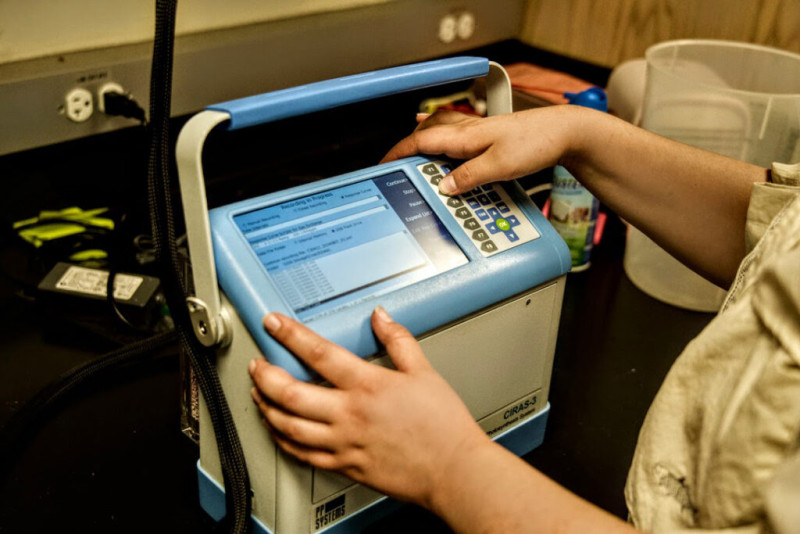
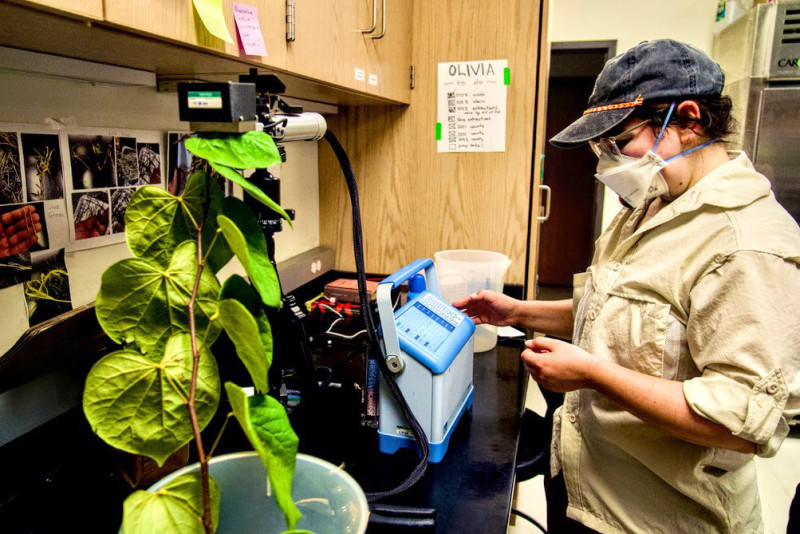
Votzke explained that she was conducting a study on the health of trees growing in different urban environments—on a street, in a forested patch, or in a park—and how such conditions impact the overall health and characteristics of various trees.
One of her assistants, Alexander Wen, a Johns Hopkins student, was hurriedly pumping air into the gun. “It’ll shoot a rope over the tree, and that way we can cut a tree limb down all the way from the top of the tree,” Votzke continued, showing the students how the meter-long saw blade was attached to the rope for sawing a branch.
Everyone looked on as the rope looped around the tree limbs. Votzke was pleased. “We always try to wear our gloves when we’re doing this because the rope can really easily bite through your hands,” she cautioned, and stretched out her hands. “Sometimes we wear hard hats if we’re doing a really big branch.”
Her assistants held the two ends of the cord, balancing the saw over the branch they wanted to cut and then showed the students how it would work without actually severing the branch.
“What do you do with the tree branches,” asked the student program coordinator, who had been trying to motivate the students to ask questions.
She explained that looking at various characteristics exhibited by trees grown in different urban settings will tell the researchers about how trees grow in Baltimore and how well different species do.
“All of those questions are going to be answered, hopefully over the next few summers. We needed a big sample size, like 200 trees to make sure that we’re saying something really accurate. That’s why we need a couple more summers,” Votzke said.
At the end of the demonstration, the students clapped, thanked the Hopkins crew, and walked away. Votzke thought it went well. Her team collected the instruments, gathered the branches they’d cut, and headed to the parking lot. Their next stop: The Johns Hopkins Earth and Planetary Sciences Department to run tree analysis in the lab.
Making Data Available to Impacted Communities
The winding, sanitized corridors of the Hopkins building were quiet and well lit. “They also research exoplanets here,” Votzke said in low tone, as she entered her lab. She then took a severed branch and placed it onto a device, which calculated the amount of carbon dioxide and other factors, and turned it on. It made a whirring sound.
One floor above, in his dimly lit corner office, Darryn Waugh looked up from his computer screen on which he plotted Zaitchik’’s bike route. Waugh oversees the atmospheric science and heat-related aspects of BSEC. Like Zaitchik, he has been all over the city visiting weather stations, measuring temperature and gathering other environmental data, all of which gets integrated in various modeling efforts.
“We’re putting out more of these weather stations, as well as taking some short-term measurements to find out how much the temperature varies on a small scale,” he said. “Simultaneously, the modeling group is getting their climate models up and running. So, we’re now starting to bring together the models with the data to evaluate how well the models are doing.”
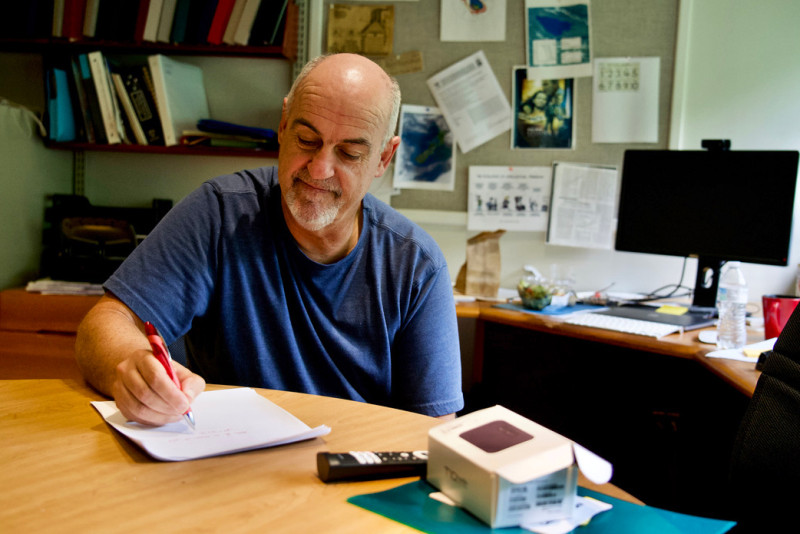
It’d been a busy summer, Waugh felt, coordinating with researchers from other universities, including Morgan State and Penn State, which are contributing to the modeling and data analysis components of the project.
He’s also involved in the community engagement and outreach efforts, something new to him. Scientists usually work in seclusion, and here he was attending meetings with local churches and community groups.
For a few months, he’d been working on creating a dashboard that he hoped would make the data accessible and useful for the local communities BSEC is partnering with, particularly in areas like Broadway East and Howard Park.
“If you asked me a year or two years ago whether I’d end up spending two months of my time working on that, I’d say no. But I’m kind of enjoying it and it’s a new aspect for me,” Waugh said. “We’re hoping we can do this science. But also, it seems like a chance to empower communities by making this data accessible for them to use to base their own decisions.”
Making hyperlocal climate measurements available to communities, he said, would also help them access adaptation funding for things like street trees and cooling centers that the Biden administration has made available through its infrastructure and environmental justice initiatives. “We’ve been trying to help some of our community partners,” he said.
To Be the Best in the World
Sitting in his office after the ride, Zaitchik reviewed the temperature measurements he and his associate had recorded. There were no major surprises.
“We knew all of those areas already,” he said. ”But it was interesting to see the data show such dramatic contrasts between a busy street and a tree-filled park, even when they’re right next to each other.”
A lesson learned, he said, was that a 17-mile ride lasting two hours led to complications for data analysis. “In the future we plan to send multiple bikes on shorter loops to get a better balance of spatial and temporal coverage,” he said.
Data from the ride was fed into machine-learning models alongside data from a weather station and a satellite to improve maps of spatial temperature variability across the city.
Those models, he said, “are our primary tool for predicting the local impacts of future climate change and potential landscape changes on the urban heat island.”
BSEC goes far beyond measuring temperature gradients across Baltimore, Zaitchik said. For instance, the project is also measuring trace gases like methane to identify infrastructure issues like gas leaks, as well as aerosol levels influenced by factors like smoke and forest fires. “This helps quantify air pollution burdens in different parts of the city.”
BSEC teams are also incorporating energy usage data from the utility company BGE to understand how heat affects energy demand and costs for residents. Another team is working with precision medical data to analyze the health impacts of heat, such as increased emergency room visits for asthma during heat waves.
“The key is integrating diverse data streams to build a comprehensive understanding of climate-related risks and resilience in Baltimore’s neighborhoods,” Zaitchik said.
In November, BSEC plans its annual community focused meeting with a small group of participants from different Baltimore neighborhoods. Zaitchik said the goal is to understand the communities’ primary concerns and priorities around topics like heat, resilience and sustainability.
The next step, Zaitchik said, will be to develop policy and investment recommendations for the city of Baltimore, with a focus on crafting equitable resilience strategies that have broad community support and can be effectively implemented. This could involve things like targeted green infrastructure investments, energy efficiency programs, or other interventions tailored to the needs of different neighborhoods.
With three years of project life remaining, Zaitchik wants BSEC to be the most meaningful urban environmental monitoring system in the world.
About This Story
Perhaps you noticed: This story, like all the news we publish, is free to read. That’s because Inside Climate News is a 501c3 nonprofit organization. We do not charge a subscription fee, lock our news behind a paywall, or clutter our website with ads. We make our news on climate and the environment freely available to you and anyone who wants it.
That’s not all. We also share our news for free with scores of other media organizations around the country. Many of them can’t afford to do environmental journalism of their own. We’ve built bureaus from coast to coast to report local stories, collaborate with local newsrooms and co-publish articles so that this vital work is shared as widely as possible.
Two of us launched ICN in 2007. Six years later we earned a Pulitzer Prize for National Reporting, and now we run the oldest and largest dedicated climate newsroom in the nation. We tell the story in all its complexity. We hold polluters accountable. We expose environmental injustice. We debunk misinformation. We scrutinize solutions and inspire action.
Donations from readers like you fund every aspect of what we do. If you don’t already, will you support our ongoing work, our reporting on the biggest crisis facing our planet, and help us reach even more readers in more places?
Please take a moment to make a tax-deductible donation. Every one of them makes a difference.
Thank you,
David Sassoon
Founder and Publisher
Vernon Loeb
Executive Editor
Share this article
- Republish
Disclaimer: The copyright of this article belongs to the original author. Reposting this article is solely for the purpose of information dissemination and does not constitute any investment advice. If there is any infringement, please contact us immediately. We will make corrections or deletions as necessary. Thank you.

